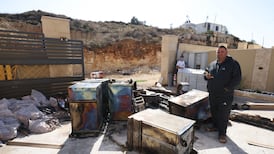Halting uranium enrichment above 5 per cent
This would keep Iran's enrichment level well below the threshold needed for weapons-grade material, which is more than 90 per cent enrichment. Uranium enriched to 5 per cent is adequate to make fuel for Iran's lone energy-producing reactor in Bushehr on the Persian Gulf coast. For Iran, the ability to keep its enrichment programme is critical. Iran's leaders insist they maintain self-sufficiency over the entire nuclear cycle from mining uranium to making nuclear fuel.
‘Neutralise’ Iran’s stockpile of 20 per cent enriched uranium
This level of enrichment is within several steps of reaching weapons grade. Eliminating the stockpile eases Western concerns that Iran could move quickly towards a nuclear weapon. Iran can either convert the 20 per cent uranium into reactor-ready fuel, which effectively blocks it from further enrichment, or it can dilute the material to levels below 5 per cent enrichment.
Iranian officials have said the country has a sufficient stockpile of 20 per cent enriched uranium for long-term operation of its research reactor, which runs at the higher-level uranium and produces isotopes for medical treatments and other uses. Allowing Iran to use the stockpile for domestic purposes is an important political takeaway for Tehran. Iranian leaders had balked at demands to ship the stockpile out of the country.
No new centrifuges
This effectively freezes Iran’s enrichment capacity for the next six months. Centrifuges are used to turn concentrated uranium into nuclear fuel. But Iran is allowed to keep its two main enrichment facilities in operation. Iran’s government would have faced a huge backlash from hardliners at home if either of the labs had been forced to shut down.
Suspend work at the Arak reactor
The planned Arak reactor in central Iran is a “heavy water” plant, which means it uses a molecular variant of water as a coolant and can run on non-enriched uranium. It also produces a higher degree of plutonium byproduct, which could be extracted and potentially used in weapons production. Iran’s agreement not to build a plutonium reprocessing facility deals directly with the weapons programme concerns. It could also clear the way for future agreements to resume work on the reactor.
Pledge to address UN concerns, including the Parchin military site
The specific mention of the Parchin military base near Tehran touches on a longstanding impasse between Iran and the UN's nuclear watchdog, the International Atomic Energy Agency. UN inspectors want to revisit the site to investigate suspicions of past explosive tests that could have applications in nuclear bomb designs. Iran denies the claim. Iran has said further inspections are possible, but also wanted to impose restrictions on public disclosures by the agency. The deal could open the way for greater Parchin inspections.
Agencies












